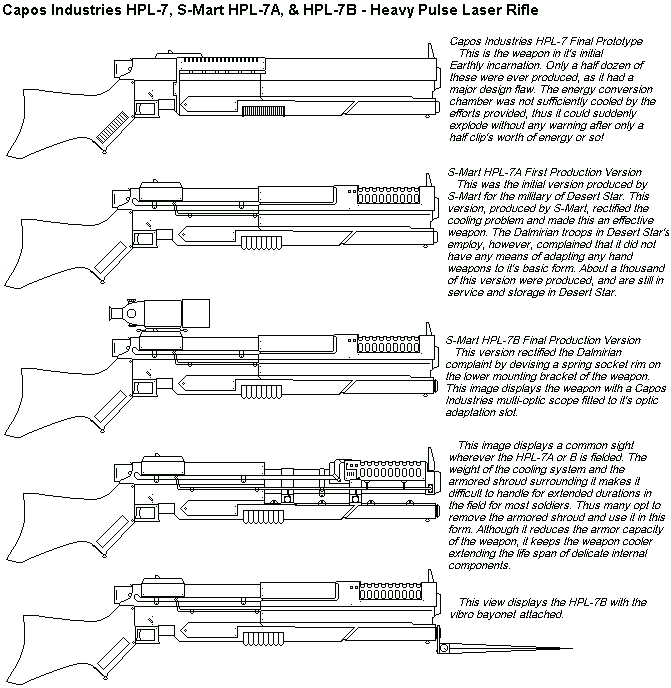

The HPL-7's origins begin far from Earth, in fact, far from the dimension Earth is even found within. It began in the Three Galaxies, on a world called Phase World, in the form of the HI-80 - a high intensity pulse laser rifle. Prior to the discovery of Project Archive and the founding of Desert Star, King Ripley was a dimensional traveler. Amidst the various places he regularly visited was Phase World, a world where intergalactic trade and indeed interdimensional trade was commonplace. It was here where Ace Ripley attained one of these magnificent laser rifles. For many years this weapon has been King Ripley's personal weapon of choice, using it whenever action was necessitated.
When Capos Industries was started up King Ripley decided to make a stab at having the skilled operators in charge of this company produce a knock-off of the HI-80. Unfortunately the technology used to produce these weapons in the CCW of the Three Galaxies is much higher than that of Earthly technology. From the outset there were troubles.
At first the chemical composition of the energy conversion chamber could not be determined - as it was vastly dissimilar from that used regularly on Earth. King Ripley graciously provided this, through one of his extradimensional sources, after an exhaustive search. After that, they had trouble keeping the intense beam from cracking the lenses. Finally when they thought they'd had it sorted out, they produced a half dozen HPL-7s and tested them. They passed with flying colors.
On the day the prototype run of completed knock-offs was unveiled, they provided a demonstration that finally culminated in King Ripley being called forth to test the new weapon for himself. Designers felt that as a long time user of the weapon they were emulating with the HPL-7, he would be the perfect person to rate how well their weapon performed. Despite having been fired dozens of times into a test target, the moment King Ripley pulled the trigger, the energy conversion chamber exploded inches away from his face. Despite the panic that ensued immediately afterwards, King Ripley suffered nothing more than a few scratches, and a singed business suit. After a thorough investigation it was discovered that the cause of the explosion was a rapid temperature increase in the energy conversion chamber walls. If it fires 24 pulse blasts or less in a minute the conversion chamber would maintain safe temperatures. The rapid fire demonstration, prior to King Ripley's attempt at firing the weapon revealed it's weakness however. Tests revealed that after a rate of fire of 48 pulse blasts per minute was reached, the temperature reached critical levels in under 15 seconds, and took several minutes to return to safe temperatures.
Techs at Capos Industries offered the idea of adding a regulator to prevent the HPL-7 from going over the safe number of pulse blasts in a minute, but Ace Ripley rejected this option. Capos Industries was still trying to solve the cooling problem when the Coalition Invasion occurred.
In 112PA the new industry, S-Mart, took over the shelved project and attacked it's problems aggressively. The regulator option not being available, giving the requirements of modern combat, a powered liquid cooling system was devised by S-Mart's Engineers. This increased weight but, after exhaustive testing and tweeking of the system, the cooling problem was rectified. This allowed for the HPL-7A, as the new version was called, to enter limited production in 114PA.
The one complaint from those it was issued to was from the Dalmirian soldiers employed within the N.O.M.A.D. military arms as castle guards. Hand held weapons in their philosophy are much more desireable to use than ranged weapons in many cases. Ranged weapons are not very subjective to whom they strike or kill, while hand held weapons can be controlled. Thus they were disappointed that the new HPL-7A had no capabilities to mount a close combat weapon anywhere on it. S-Mart responded with the HPL-7B.
The HPL-7B is very similar to the 7A and, since they entered production in 115PA, they have served side by side in the N.O.M.A.D. military arms. (ALL Castle Guards are issued 7Bs.) The only real difference being that the 7B has a spring socket rim on the end of the lower mounting bracket, permitting the use of a vibro-bayonet.
Of the original six prototype knock-off weapons produced, two were destroyed during testing - including the one that nearly killed King Ripley. The other four disappeared during the Coalition Invasion of Desert Star. It was initially believed that these fell into the hands of the Coalition States, taken to Chi-Town or Lone Star for analysis. In 118PA however a Tolkeenite elven man named Zagahma Felora sold a Capos Industries HPL-7 to a collector in Lazlo for a whopping sum of 825,000 credits! The fate of the other three remains a mystery. The remaining few thousand that have been produced have been restricted to sale to the N.O.M.A.D. military arms, and are presently in their service, mostly in the hands of Special Operations unit members, elite castle guards, or as a specially issued weapon for sharp shooters. Counting the occasional lost weapon and the mysterious displacement of a small handful of weapons, it is thought that less than a hundred of these rifles could have made their way into the hands of private individuals. (In all reality about 150 have made their way to the hands of Black Marketeers, including those pieced together from spare parts.)